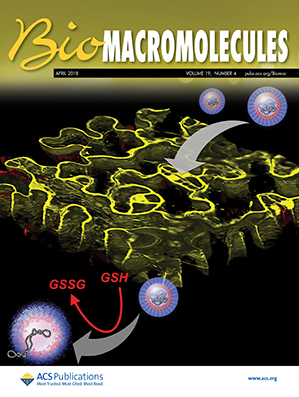Two-Step Carboxymethylation of Cellulose from Halocynthia roretzi Using Ionic Liquid
IF 5.4
2区 化学
Q1 BIOCHEMISTRY & MOLECULAR BIOLOGY
引用次数: 0
Abstract
Water-soluble carboxymethylated tunicate cellulose (CMTC) was produced using cellulose from Halocynthia roretzi, known for its uniquely high molecular weight and crystallinity. Among various known methods for cellulose carboxymethylation tested in this study, only the homogeneous method using LiClO4 yielded water-soluble CMTC. However, industrial application of this method is hindered by LiClO4’s toxicity, explosiveness, and high cost. Therefore, we developed a two-step carboxymethylation process utilizing [Emim][Ac], effectively converting crystalline cellulose into an amorphous form and reducing both the degree of polymerization (DP) and polydispersity index (PDI). CMTC prepared by this two-step method exhibited a high degree of substitution (DS = 1.94), excellent water solubility (>100 mg/g), and superior thermal stability. Compared to the LiClO4-based CMTC, our product contained only 5% unmodified glucose and demonstrated significantly enhanced thickening properties, with 8-fold greater viscosity in 5% aqueous solutions. Structural properties were confirmed via HPLC, 1H NMR, XRD, FT-IR, and TGA analyses.
- Download: Download high-res image (220KB)
- Download: Download full-size image
离子液体对盐藻纤维素两步羧甲基化的研究。
水溶性羧基甲基化束状膜纤维素(CMTC)是利用具有独特的高分子量和结晶度的褐藻(Halocynthia roretzi)纤维素制备的。在本研究中测试的各种纤维素羧甲基化方法中,只有使用LiClO4的均相方法得到水溶性CMTC。然而,这种方法的工业应用受到LiClO4的毒性,爆炸性和高成本的阻碍。因此,我们利用[Emim][Ac]开发了一种两步羧甲基化工艺,有效地将结晶纤维素转化为无定形,并降低了聚合度(DP)和多分散性指数(PDI)。两步法制备的CMTC取代度高(DS = 1.94),水溶性好(>100 mg/g),热稳定性好。与基于liclo4的CMTC相比,我们的产品仅含有5%未修饰的葡萄糖,并且显着增强了增稠性能,在5%的水溶液中粘度提高了8倍。通过HPLC, 1H NMR, XRD, FT-IR和TGA分析确定了结构性质。
本文章由计算机程序翻译,如有差异,请以英文原文为准。
求助全文
约1分钟内获得全文
求助全文
来源期刊

Biomacromolecules
化学-高分子科学
CiteScore
10.60
自引率
4.80%
发文量
417
审稿时长
1.6 months
期刊介绍:
Biomacromolecules is a leading forum for the dissemination of cutting-edge research at the interface of polymer science and biology. Submissions to Biomacromolecules should contain strong elements of innovation in terms of macromolecular design, synthesis and characterization, or in the application of polymer materials to biology and medicine.
Topics covered by Biomacromolecules include, but are not exclusively limited to: sustainable polymers, polymers based on natural and renewable resources, degradable polymers, polymer conjugates, polymeric drugs, polymers in biocatalysis, biomacromolecular assembly, biomimetic polymers, polymer-biomineral hybrids, biomimetic-polymer processing, polymer recycling, bioactive polymer surfaces, original polymer design for biomedical applications such as immunotherapy, drug delivery, gene delivery, antimicrobial applications, diagnostic imaging and biosensing, polymers in tissue engineering and regenerative medicine, polymeric scaffolds and hydrogels for cell culture and delivery.
 求助内容:
求助内容: 应助结果提醒方式:
应助结果提醒方式:


